
The Chicago "L" is the rapid transit system serving the city of Chicago and some of its surrounding suburbs in the U.S. state of Illinois. Operated by the Chicago Transit Authority (CTA), it is the fourth-largest rapid transit system in the United States in terms of total route length, at 102.8 miles (165.4 km) long as of 2014, and the third-busiest rapid transit system in the United States, after the New York City Subway and Washington Metro. In 2016, the "L" had 1,492 rail cars, eight different routes, and 145 train stations. In 2022, the system had 103,524,900 rides, or about 367,000 per weekday in the second quarter of 2023.

The Blue Line is a 26.93-mile-long (43.34 km) Chicago "L" line which extends through The Loop from O'Hare International Airport at the far northwest end of the city, through downtown via the Milwaukee–Dearborn subway and across the West Side to its southwest end at Forest Park, with a total of 33 stations. At about 27 miles, it is the longest line on the Chicago "L" system and second busiest, and one of the longest local subway/elevated lines in the world. It has an average of 64,978 passengers boarding each weekday in 2022.

The Green Line is a rapid transit line in Chicago, Illinois, operated by the Chicago Transit Authority (CTA) as part of the Chicago "L" system. It is the only completely elevated route in the "L" system. All other routes may have various combinations of elevated, subway, street level, or freeway median sections.
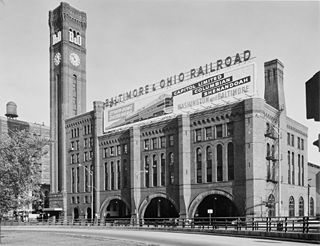
Grand Central Station was a passenger railroad terminal in downtown Chicago, Illinois, from 1890 to 1969. It was located at 201 West Harrison Street on a block bounded by Harrison, Wells and Polk Streets and the Chicago River in the southwestern portion of the Chicago Loop. Grand Central Station was designed by architect Solon Spencer Beman for the Wisconsin Central Railroad (WC), and was completed by the Chicago and Northern Pacific Railroad.

47th is a station on the Chicago Transit Authority's "L" system, located in the Grand Boulevard community area of Chicago, Illinois and serving the Green Line. It is situated at 314 E 47th Street, three blocks east of State Street. It opened on August 15, 1892, when South Side Elevated Railroad extended its service south to serve the Chicago World's Fair in 1893.

Cottage Grove, is an 'L' station and the current terminus of the CTA Green Line's East 63rd branch, located in the Woodlawn neighborhood. The station, situated at 800 East 63rd Street, opened on April 23, 1893. This station is the current terminal of the East 63rd branch of the Green Line, and the easternmost station on the 'L' system.

Ashland is an 'L' station on the CTA's Green and Pink Lines. It is an elevated station with two side platforms, located in Chicago's Near West Side neighborhood at 1601 West Lake Street. Just to the west of the station, the Pink Line branches off from the Lake Street branch to follow the Paulina Connector to the Douglas branch. The adjacent stations are California (Green), which is located about 1+1⁄2 miles (2.4 km) to the west, Polk (Pink), which is located about 1 mile (1.6 km) to the south, and Morgan station, approximately 3⁄4 mile (1.2 km) to the east.

Forest Park is a station on the Chicago Transit Authority's 'L' system, located in the village of Forest Park, Illinois and serving the Blue Line. Before the Congress Line was built, it served as terminal for the Garfield Line. It is the western terminus of the Forest Park branch. The station was known as Des Plaines until 1994. It is also referred to as the Forest Park Transit Center by Pace because it is a major terminal for Pace buses. The station contains a 1,051-space Park and Ride lot which uses the "Pay and Display" system, in which fees are paid at the lot entrance. It is located south of the Baltimore and Ohio Chicago Terminal Railroad tracks which curve to the north of the station towards Madison Street where the line rechristens itself to the Canadian National Railway's Waukesha Subdivision.

The South Side Elevated Railroad was the first elevated rapid transit line in Chicago, Illinois. The line ran from downtown Chicago to Jackson Park, with branches to Englewood, Normal Park, Kenwood, and the Union Stock Yards. The first 3.6 miles (5.8 km) of the line opened on June 6, 1892. Much of its route is still used today as part of the Green Line of the Chicago "L" system.
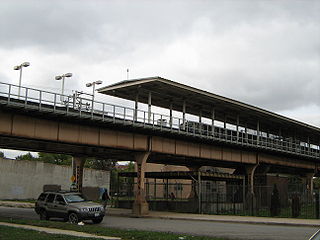
58th was a station on the Chicago Transit Authority's Green Line in the Washington Park neighborhood of Chicago, Illinois. The station was located at 320-24 E. 58th Street. 58th opened on January 22, 1893, as part of the South Side Elevated Railroad's expansion to serve the World's Columbian Exposition. The station closed with the rest of the Green Line on January 9, 1994, but did not reopen with the rest of the Green Line on May 12, 1996, because of its close proximity to the Garfield station.

The Northwestern Elevated Railroad was the last of the privately constructed rapid transit lines to be built in Chicago. The line ran from the Loop in downtown Chicago north to Wilson Avenue in Chicago's Uptown neighborhood with a branch to Ravenswood and Albany Park that left the main line at Clark Street. The Ravenswood line is now operated as the Brown Line, while the Main Line is used by the Purple and Red Lines.
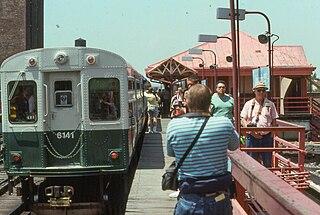
University was a station on the Chicago Transit Authority's Green Line; The station was located at 1200 East 63rd Street in the Woodlawn neighborhood of Chicago. University opened on April 23, 1893. From December 12, 1982, until January 9, 1994, University served as the terminal of the Jackson Park Branch. The station closed on January 9, 1994, when the entire Green Line closed for a renovation project. University did not reopen with the rest of the Green Line on May 12, 1996. University was scheduled to be replaced by a new terminal at Dorchester. Instead the line was cut back to its current terminal at Cottage Grove. The University station was demolished in September 1997 when the City of Chicago demolished the rest of the Jackson Park branch east of Cottage Grove.
29th was a rapid transit station on the Chicago "L"'s South Side main line. Originally constructed by the South Side Elevated Railroad company, it was one of the original ten stations opened on the Chicago "L", beginning service on June 6, 1892. The South Side Elevated Railroad merged operations with three other companies to form Chicago Elevated Railways (CER) in 1911, before merging outright with them in 1924 to form the Chicago Rapid Transit Company (CRT). Public ownership came to the "L" in 1947 with the Chicago Transit Authority (CTA).
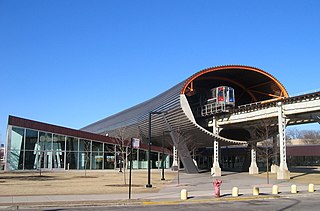
The South Side Elevated is a branch of the Chicago "L" system in Chicago, Illinois that is served by the Green Line. It has on average 12,509 passengers, counting branch divisions, boarding each weekday as of February 2013, according to the Chicago Transit Authority. The branch is 6.5 miles (10.5 km) long with a total of 8 stations, and runs from the Near South Side to the Washington Park neighborhood of Chicago.

Dorchester was a station on the Jackson Park branch of the Chicago "L". The station opened on April 23, 1893 and closed on January 13, 1973, as part of a group of budget-related CTA station closings. Dorchester was scheduled to be the new terminal of the Jackson Park Branch, but the CTA decided to make Cottage Grove the new terminal, because the Reverend Arthur Brazier and some other Woodlawn residents thought the 'L' structure over East 63rd Street would further blight Woodlawn and prevent redevelopment.

The Lake Street Elevated, also known as the Lake branch, is a 8.75 mi (14.08 km) long branch of the Chicago "L" which is located west of the Chicago Loop and serves the Green Line for its entire length, as well as the Pink Line east of Ashland Avenue. As of February 2013, the branch serves an average of 27,217 passengers each weekday. It serves the Near West Side, East Garfield Park, West Garfield Park, and Austin neighborhoods of Chicago, as well as the suburbs Oak Park and Forest Park. It owes its name to Lake Street, the street that the branch overlooks for 6.25 mi (10.06 km) before continuing its route straight west, adjacent to South Boulevard, towards the terminus at Harlem/Lake.

The East 63rd branch, formerly known as the Jackson Park branch, is a 1.5-mile (2.4 km) long branch of the Chicago "L" operated as part the Green Line by the Chicago Transit Authority, serving the Woodlawn neighborhood of Chicago, Illinois.
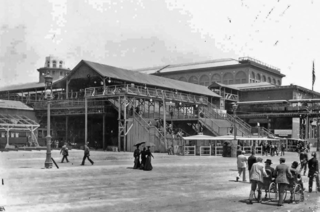
Jackson Park was a terminal on the Jackson Park Branch of the Chicago 'L'. The station opened on May 12, 1893, and closed on October 31, 1893, with the conclusion of the World's Columbian Exposition.



















